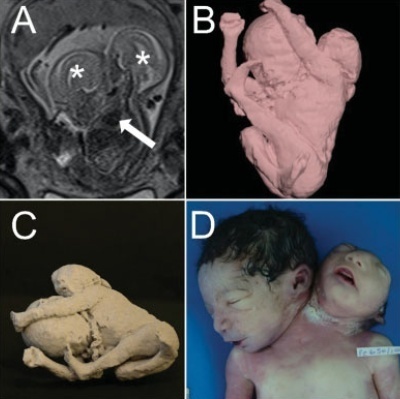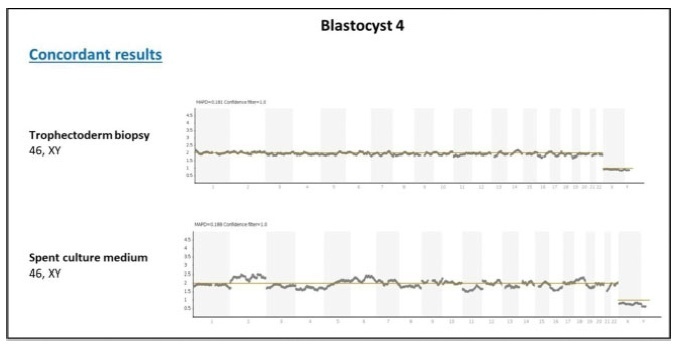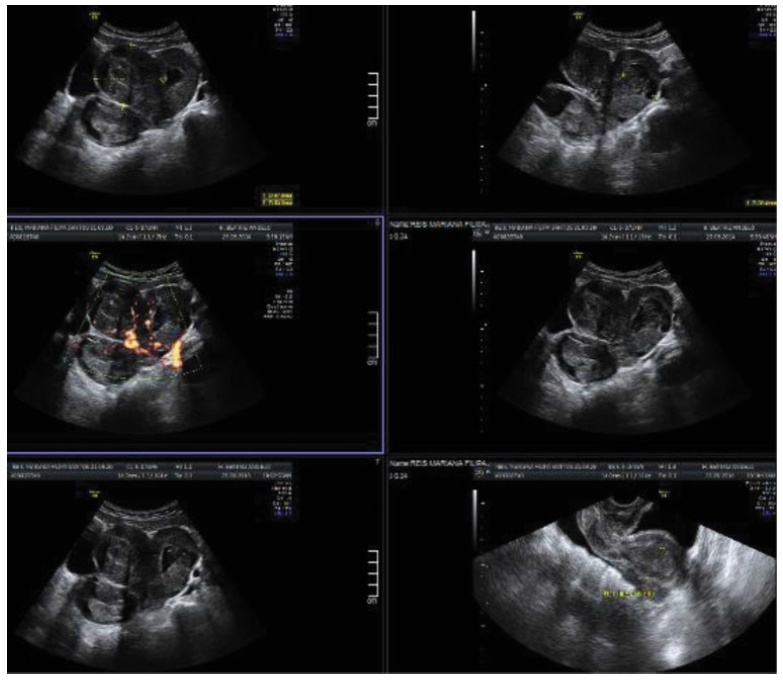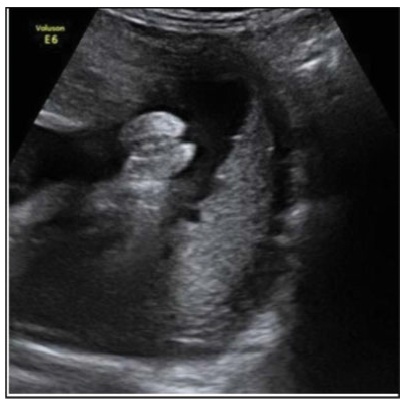Summary
Revista Brasileira de Ginecologia e Obstetrícia. 2024;46:e-rbgo12
Endometriosis is a complex disease that affects 10-15% of women of reproductive age. Familial studies show that relatives of affected patients have a higher risk of developing the disease, implicating a genetic role for this disorder. Little is known about the impact of germline genomic copy number variant (CNV) polymorphisms on the heredity of the disease. In this study, we describe a rare CNV identified in two sisters with familial endometriosis, which contain genes that may increase the susceptibility and progression of this disease. We investigated the presence of CNVs from the endometrium and blood of the sisters with endometriosis and normal endometrium of five women as controls without the disease using array-CGH through the Agilent 2x400K platform. We excluded common CNVs that were present in the database of genomic variation. We identified, in both sisters, a rare CNV gain affecting 113kb at band 3q12.2 involving two candidate genes: ADGRG7 and TFG. The CNV gain was validated by qPCR. ADGRG7 is located at 3q12.2 and encodes a G protein-coupled receptor influencing the NF-kappaβ pathway. TFG participates in chromosomal translocations associated with hematologic tumor and soft tissue sarcomas, and is also involved in the NF-kappa B pathway. The CNV gain in this family provides a new candidate genetic marker for future familial endometriosis studies. Additional longitudinal studies of affected families must confirm any associations between this rare CNV gain and genes involved in the NF-kappaβ pathway in predisposition to endometriosis.
Summary
Revista Brasileira de Ginecologia e Obstetrícia. 2023;45(5):273-280
Pituitary apoplexy refers to a rare clinical syndrome consisting of signs and symptoms that occur due to rapid expansion of the contents of the sella turcica. It can occur spontaneously or associated with pituitary tumors. It can have a broad clinical spectrum, but usually presents with severe headache, visual impairment and hypopituitarism. Sudden onset of symptoms associated to imagiologic confirmation makes the diagnosis. Surgical treatment is advised when there is important compression of the optic tract. We present a case report and a review of the literature on pituitary apoplexy in pregnancy. The cases were reviewed to obtain information on maternal characteristics, clinical presentation, diagnostic studies, therapeutic modalities and maternal and fetal outcomes. Our review found 36 cases of pituitary apoplexy in pregnancy. Most of the cases occurred in the second trimester of pregnancy and headache was the most frequent symptom at presentation. Surgical therapy was required in more than half of the patients. In what respect maternal and fetal outcomes, there were 3 cases of preterm delivery and one case of maternal death. Our clinical case and literature review reinforces the importance of an early diagnosis to avoid potential adverse consequences.
Summary
Revista Brasileira de Ginecologia e Obstetrícia. 2023;45(6):333-336
Isthmocele is a discontinuation of the myometrium at the uterine scar site in a patient with a previous cesarian section (CS). The cause of isthmocele appears to be multifactorial. Poor surgical technique, low incision location, uterine retroflection, obesity, smoking, inadequate healing of scars, and maternal age are possible related factors. Most patients with this condition are asymptomatic. However, women can present with postmenstrual bleeding, pelvic pain, subfertility, dysmenorrhea, infertility, and scar abscess. Brazil has one of the world s highest cesarean section rates. One of the consequences of the rising rate of CS is the isthmocele, an emerging female health problem. Here we report a case of mucinous cystadenoma arising in a uterine isthmocele, a complication, as far as we could investigate, not yet described in the literature.
Summary
Revista Brasileira de Ginecologia e Obstetrícia. 2021;43(12):985-987
Conjoined twins (CTs) are a rare complication from monochorionic and monoamniotic twin pregnancies. We describe the use of 3D technologies, including 3D virtual and 3D physical models on prenatal evaluation of one parapagus CT. A 16-year-old G1P0 woman was referred for fetal magnetic resonance imaging (MRI) anatomical evaluation of a CT at 28 weeks of gestation. 3D images of the fetal surface were generated by the software during the examination for spatial comprehension of the relationship between the fetal parts. The pair of CTs died at the 32nd week of gestation, a few hours after cesarean section. 3D technologies are an important tool for parental counseling and preparation of the multidisciplinary care team for delivery and neonatal assistance and possible surgical planning for postnatal separation in CTs cases.

Summary
Revista Brasileira de Ginecologia e Obstetrícia. 2021;43(11):878-882
Non-invasive preimplantation genetic testing for aneuploidies (niPGT-A) aiming to assess cell-free embryonic DNA in spent culturemedia is promising, especially because it might overcome the diminished rates of implantation caused by the inadequate performance of trophectoderm (TE) biopsy. Our center is part of the largest study to date assessing the concordance between conventional PGT-A and niPGT-A, and we report here the delivery of the first baby born in Brazil using niPGT-A. The parents of the baby were admitted to our center in 2018. They did not present history of infertility, and they were interested in using in vitro fertilization (IVF) and PGT-A in order to avoid congenital anomalies in the offspring. A total of 11 (3 day-5 and 8 day-6) expanded blastocysts were biopsied, and the spent culture media (culture from day-4 to day-6) from 8 day-6 blastocysts were collected for niPGT-A. Overall, 7 embryos yielded informative results for trophectoderm (TE) and media samples. Among the embryos with informative results, 5 presented concordant diagnosis between conventional PGTA and niPGT-A, and 2 presented discordant diagnosis (1 false-positive and one falsenegative). The Blastocyst 4, diagnosed as 46, XY by both niPGT-A and conventional PGTA, was warmed up and transferred, resulting in the birth of a healthy 3.8 kg boy in February 2020. Based on our results and the recent literature, we believe that the safest current application of niPGT-A would be as a method of embryo selection for patients without an indication for conventional PGT-A. The approximate 80% of reliability of niPGT-A in the diagnosis of ploidy is superior to predictions provided by other noninvasive approaches like morphology and morphokinetics selection.

Summary
Revista Brasileira de Ginecologia e Obstetrícia. 2021;43(10):789-792
Abnormal uterine bleeding is more frequent in adolescence. Although, most commonly, it has a non-structural etiology, it may be due to any cause described.
A 12-year-old adolescent, with no relevant personal history, menarche 1 month before, was observed in the emergency department for severemenstrual bleeding with progressive worsening, and hemodynamic repercussion in need of transfusion support. Physiological ovulatory dysfunction associated with possible previously unknown coagulopathy was considered to be the most likely diagnosis and medical treatment was initiated. Without response, the patient was submitted to sedated observation and uterine aspiration, which ultimately led to the diagnosis of a Burkitt Lymphoma.
Although structural causes, and particularly malignancy, whether gynecological or not, are a rare cause of abnormal uterine bleeding in this age group, they must be considered, thus enhancing the fastest and most appropriate treatment.

Summary
Revista Brasileira de Ginecologia e Obstetrícia. 2021;43(9):710-712
With the widespread uptake of noninvasive prenatal testing (NIPT), a larger cohort of women has access to fetal chromosomal sex, which increases the potential to identify prenatal sex discordance. The prenatal diagnosis of androgen insensitivity syndrome (AIS) is an incidental and rare finding. We wish to present the diagnosis of a prenatal index case after NIPT of cell-free fetal DNA and mismatch between fetal sex and ultrasound phenotype. In this particular case, the molecular analysis of the androgen receptor (AR) gene showed the presence of a pathogenic mutation, not previously reported, consistent with complete androgen insensitivity syndrome. Carrier testing for the mother revealed the presence of the same variant, confirming maternal hemizygous inheritance. Identification of the molecular basis of these genetic conditions enables the preimplantation or prenatal diagnosis in future pregnancies.
